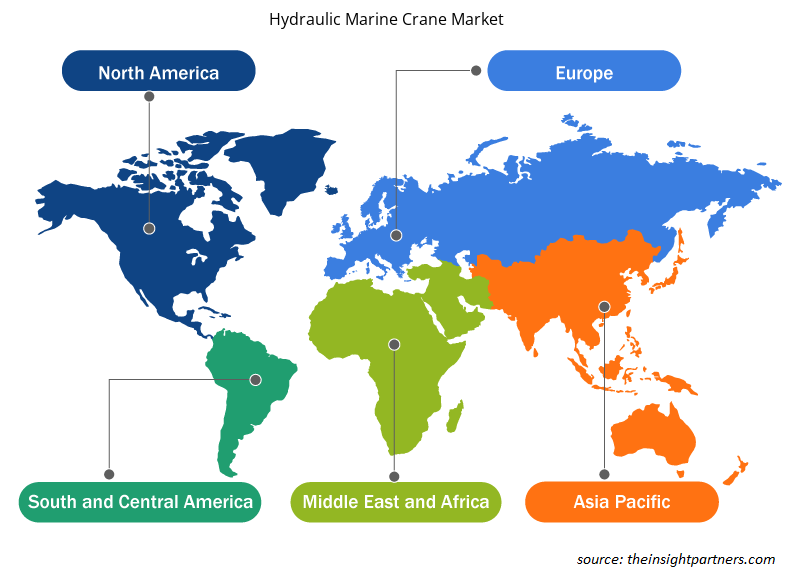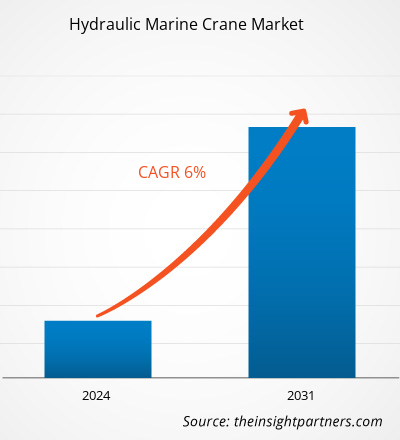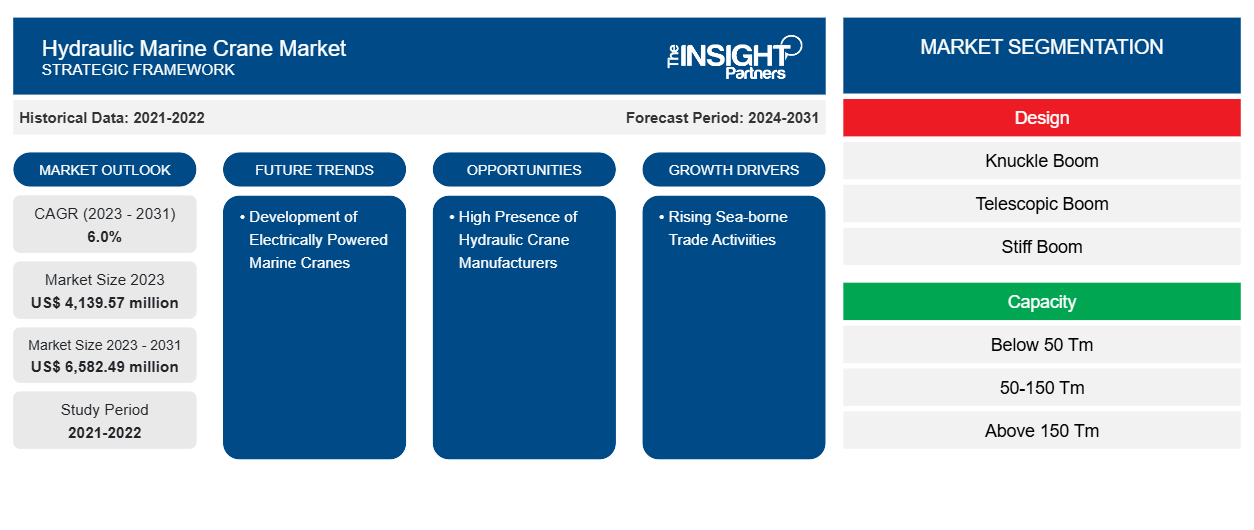Si prevede che la dimensione del mercato delle gru idrauliche marine raggiungerà i 6.582,49 milioni di dollari entro il 2031, rispetto ai 4.139,57 milioni di dollari del 2023. Si prevede che il mercato registrerà un CAGR del 6,0% nel periodo 2023-2031. Il crescente numero di attività commerciali via mare e la crescente attenzione del governo allo sviluppo delle infrastrutture marittime rimarranno probabilmente una tendenza chiave nel mercato.
Analisi del mercato delle gru idrauliche marine
Diversi investimenti governativi nella costruzione di infrastrutture marittime hanno aumentato la domanda di mercato per le gru idrauliche marine. Un gran numero di costruttori di navi porterebbe direttamente all'aumento della domanda di gru idrauliche marine a livello globale. Le regioni sviluppate come il Nord America e l'Europa hanno i principali produttori di gru marine come DMW Marine Group e Fred Wahl Marine Construction, Inc., che offre gru marine di tipo knuckle boom, telescopic boom e stiff-boom. Tutte queste aumenteranno la crescita del mercato delle gru idrauliche marine.
Panoramica del mercato delle gru idrauliche marine
I crescenti sviluppi tecnologici consentono ai lavoratori di rimanere agili. L'integrazione di tecnologie avanzate all'interno di navi e diversi progetti offshore guiderebbe la crescita del mercato delle gru idrauliche marine a livello globale. Paesi come l'Arabia Saudita stanno acquistando flotte di trasporto marittimo che migliorerebbero l'implementazione di tecnologie avanzate in diverse navi, come navi cargo e navi militari, tra le altre. Per implementare e costruire nuove infrastrutture tecnologiche, sarebbe richiesta la necessità di gru marine, che sta guidando la domanda di gru idrauliche marine.
Personalizza questo report in base alle tue esigenze
Riceverai la personalizzazione gratuita di qualsiasi report, comprese parti di questo report, o analisi a livello nazionale, pacchetto dati Excel, oltre a usufruire di grandi offerte e sconti per start-up e università
-
Scopri le principali tendenze di mercato in questo rapporto.Questo campione GRATUITO includerà analisi di dati che spaziano dalle tendenze di mercato alle stime e alle previsioni.
Driver e opportunità del mercato delle gru idrauliche marine
Crescita delle attività commerciali via mare per favorire il mercato
Le politiche e le normative governative a favore delle attività commerciali internazionali attraggono investimenti esteri. Inoltre, diversi governi si concentrano sullo sviluppo dell'industria marittima e sull'attrazione di IDE in questo settore, il che sta aumentando le attività commerciali via mare e influenzando positivamente il mercato delle gru idrauliche. I crescenti progetti di sviluppo tecnologico realizzati nei porti e nelle costruzioni navali stanno influenzando positivamente le attività commerciali. Il crescente numero di attività commerciali via mare richiede infrastrutture portuali e strutture di banchina adeguate per soddisfare il gran numero di navi commerciali, che sta agendo come un importante motore per il mercato delle gru idrauliche a livello globale.
Elevata presenza di produttori di gru idrauliche
Il numero di produttori di gru marine in regioni come Europa, Asia Pacifico e Nord America è elevato rispetto ad altre regioni. Italia, Cina e Stati Uniti sono tra i principali paesi con i maggiori produttori di gru marine. I tipi di gru marine disponibili in queste regioni sono gru marine a braccio articolato, a braccio telescopico e a braccio rigido. Pertanto, con un numero maggiore di produttori di gru marine presenti, si prevede che il mercato avrà una crescita positiva. Gli Stati Uniti hanno anche un gran numero di produttori di navi, il che porterebbe direttamente all'aumento della domanda di gru marine idrauliche.
Analisi della segmentazione del rapporto di mercato delle gru idrauliche marine
I segmenti chiave che hanno contribuito alla derivazione dell'analisi di mercato delle gru marine idrauliche sono la progettazione, la capacità e la lunghezza del braccio.
- In base al design, il mercato delle gru idrauliche marine è suddiviso in braccio articolato, braccio telescopico , braccio rigido e braccio pieghevole. Il segmento del braccio pieghevole ha detenuto una quota di mercato maggiore nel 2023.
- In base alla capacità, il mercato è segmentato in sotto 50 Tm, 50-150 Tm e sopra 150 Tm. Il segmento 50 – 150 Tm ha detenuto una quota significativa del mercato nel 2023.
- In base alla lunghezza del braccio, il mercato è segmentato in sotto i 10 metri, 10-20 metri e sopra i 20 metri. Il segmento sotto i 10 metri ha detenuto una quota significativa del mercato nel 2023.
Analisi della quota di mercato delle gru idrauliche marine per area geografica
L'ambito geografico del rapporto sul mercato delle gru marine idrauliche è suddiviso principalmente in cinque regioni: Nord America, Asia Pacifico, Europa, Medio Oriente e Africa, e Sud e Centro America.
L'Europa è leader di mercato. Gli elevati investimenti governativi nello sviluppo delle infrastrutture marittime hanno influenzato positivamente la domanda di mercato delle gru idrauliche marine nella regione. I crescenti progetti di sviluppo tecnologico nei porti e nella produzione navale stanno aumentando la domanda di gru idrauliche marine nei mercati europei. L'Europa è una regione economicamente avanzata. Regno Unito, Spagna, Italia, Francia, Germania, Svizzera, Russia, Svezia e Paesi Bassi sono alcuni dei principali paesi della regione. L'elevata presenza di costruttori di gru idrauliche e cantieri navali sta avendo un impatto positivo anche sul mercato delle gru idrauliche marine in Europa.
Approfondimenti regionali sul mercato delle gru idrauliche marine
Le tendenze regionali e i fattori che influenzano il mercato delle gru idrauliche marine durante il periodo di previsione sono stati ampiamente spiegati dagli analisti di Insight Partners. Questa sezione discute anche i segmenti e la geografia del mercato delle gru idrauliche marine in Nord America, Europa, Asia Pacifico, Medio Oriente e Africa e Sud e Centro America.

- Ottieni i dati specifici regionali per il mercato delle gru idrauliche marine
Ambito del rapporto di mercato sulle gru idrauliche marine
| Attributo del report | Dettagli |
|---|---|
| Dimensioni del mercato nel 2023 | 4.139,57 milioni di dollari USA |
| Dimensioni del mercato entro il 2031 | 6.582,49 milioni di dollari USA |
| CAGR globale (2023-2031) | 6,0% |
| Dati storici | 2021-2022 |
| Periodo di previsione | 2024-2031 |
| Segmenti coperti |
Per progettazione
|
| Regioni e Paesi coperti |
America del Nord
|
| Leader di mercato e profili aziendali chiave |
|
Densità degli attori del mercato: comprendere il suo impatto sulle dinamiche aziendali
Il mercato delle gru idrauliche marine sta crescendo rapidamente, spinto dalla crescente domanda degli utenti finali dovuta a fattori quali l'evoluzione delle preferenze dei consumatori, i progressi tecnologici e una maggiore consapevolezza dei vantaggi del prodotto. Con l'aumento della domanda, le aziende stanno ampliando le loro offerte, innovando per soddisfare le esigenze dei consumatori e capitalizzando sulle tendenze emergenti, il che alimenta ulteriormente la crescita del mercato.
La densità degli operatori di mercato si riferisce alla distribuzione di aziende o società che operano in un particolare mercato o settore. Indica quanti concorrenti (operatori di mercato) sono presenti in un dato spazio di mercato in relazione alle sue dimensioni o al valore di mercato totale.
Le principali aziende che operano nel mercato delle gru idrauliche marine sono:
- Amco Veba Marine
- Gruppo marino Dmw
- Fassi Gru SpA
- Impresa edile Fred Wahl Marine Construction, Inc.
- Heila Cranes SpA
- Industria Idraulica AB
Disclaimer : le aziende elencate sopra non sono classificate secondo un ordine particolare.

- Ottieni una panoramica dei principali attori del mercato delle gru idrauliche marine
Notizie e sviluppi recenti sul mercato delle gru idrauliche marine
Il mercato delle gru idrauliche marine viene valutato raccogliendo dati qualitativi e quantitativi dopo la ricerca primaria e secondaria, che include importanti pubblicazioni aziendali, dati associativi e database. Di seguito sono elencati alcuni degli sviluppi nel mercato delle gru idrauliche marine:
- Amco Veba Marine ha lanciato gru marine da 40tm. (Fonte: Amco Veba Marine, comunicato stampa, maggio 2022)
- Le categorie di gru V820NM e V823NM di Amco Veba Marine sono state certificate da DNV in conformità allo standard DNV-ST-0377 per gli apparecchi di sollevamento a bordo nave. (Fonte: Amco Veba Marine, comunicato stampa, settembre 2022)
Copertura e risultati del rapporto sul mercato delle gru idrauliche marine
Il rapporto "Dimensioni e previsioni del mercato delle gru marine idrauliche (2021-2031)" fornisce un'analisi dettagliata del mercato che copre le seguenti aree:
- Dimensioni e previsioni del mercato delle gru marine idrauliche a livello globale, regionale e nazionale per tutti i principali segmenti di mercato coperti dall'ambito
- Tendenze del mercato delle gru idrauliche marine e dinamiche di mercato come fattori trainanti, vincoli e opportunità chiave
- Analisi PEST e SWOT dettagliate
- Analisi di mercato delle gru idrauliche marine che copre le principali tendenze del mercato, il quadro globale e regionale, i principali attori, le normative e i recenti sviluppi del mercato
- Analisi del panorama industriale e della concorrenza che copre la concentrazione del mercato, l'analisi della mappa di calore, i principali attori e gli sviluppi recenti per il mercato delle gru idrauliche marine
- Profili aziendali dettagliati
- Analisi storica (2 anni), anno base, previsione (7 anni) con CAGR
- Analisi PEST e SWOT
- Valore/volume delle dimensioni del mercato - Globale, Regionale, Nazionale
- Industria e panorama competitivo
- Set di dati Excel
Report recenti
Rapporti correlati
Testimonianze
Motivo dell'acquisto
- Processo decisionale informato
- Comprensione delle dinamiche di mercato
- Analisi competitiva
- Analisi dei clienti
- Previsioni di mercato
- Mitigazione del rischio
- Pianificazione strategica
- Giustificazione degli investimenti
- Identificazione dei mercati emergenti
- Miglioramento delle strategie di marketing
- Aumento dell'efficienza operativa
- Allineamento alle tendenze normative























 Ottieni un campione gratuito per - Mercato delle gru idrauliche marine
Ottieni un campione gratuito per - Mercato delle gru idrauliche marine